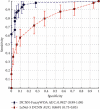DCNN-FuzzyWOA: Artificial Intelligence Solution for Automatic Detection of COVID-19 Using X-Ray Images
- PMID: 35965746
- PMCID: PMC9363937
- DOI: 10.1155/2022/5677961
DCNN-FuzzyWOA: Artificial Intelligence Solution for Automatic Detection of COVID-19 Using X-Ray Images
Abstract
Artificial intelligence (AI) techniques have been considered effective technologies in diagnosing and breaking the transmission chain of COVID-19 disease. Recent research uses the deep convolution neural network (DCNN) as the discoverer or classifier of COVID-19 X-ray images. The most challenging part of neural networks is the subject of their training. Descent-based (GDB) algorithms have long been used to train fullymconnected layer (FCL) at DCNN. Despite the ability of GDBs to run and converge quickly in some applications, their disadvantage is the manual adjustment of many parameters. Therefore, it is not easy to parallelize them with graphics processing units (GPUs). Therefore, in this paper, the whale optimization algorithm (WOA) evolved by a fuzzy system called FuzzyWOA is proposed for DCNN training. With accurate and appropriate tuning of WOA's control parameters, the fuzzy system defines the boundary between the exploration and extraction phases in the search space. It causes the development and upgrade of WOA. To evaluate the performance and capability of the proposed DCNN-FuzzyWOA model, a publicly available database called COVID-Xray-5k is used. DCNN-PSO, DCNN-GA, and LeNet-5 benchmark models are used for fair comparisons. Comparative parameters include accuracy, processing time, standard deviation (STD), curves of ROC and precision-recall, and F1-Score. The results showed that the FuzzyWOA training algorithm with 20 epochs was able to achieve 100% accuracy, at a processing time of 880.44 s with an F1-Score equal to 100%. Structurally, the i-6c-2s-12c-2s model achieved better results than the i-8c-2s-16c-2s model. However, the results of using FuzzyWOA for both models have been very encouraging compared to particle swarm optimization, genetic algorithm, and LeNet-5 methods.
Copyright © 2022 Abbas Saffari et al.
Conflict of interest statement
The authors declare that they have no conflicts of interest.
Figures






Similar articles
-
Improved deep convolutional neural networks using chimp optimization algorithm for Covid19 diagnosis from the X-ray images.Expert Syst Appl. 2023 Mar 1;213:119206. doi: 10.1016/j.eswa.2022.119206. Epub 2022 Nov 4. Expert Syst Appl. 2023. PMID: 36348736 Free PMC article.
-
COVID-19 diagnosis using chest CT scans and deep convolutional neural networks evolved by IP-based sine-cosine algorithm.Med Biol Eng Comput. 2022 Oct;60(10):2931-2949. doi: 10.1007/s11517-022-02637-6. Epub 2022 Aug 12. Med Biol Eng Comput. 2022. PMID: 35962266 Free PMC article.
-
Pulmonary Diffuse Airspace Opacities Diagnosis from Chest X-Ray Images Using Deep Convolutional Neural Networks Fine-Tuned by Whale Optimizer.Wirel Pers Commun. 2022;124(2):1355-1374. doi: 10.1007/s11277-021-09410-2. Epub 2021 Dec 1. Wirel Pers Commun. 2022. PMID: 34873379 Free PMC article.
-
Artificial intelligence and machine learning approaches in composting process: A review.Bioresour Technol. 2023 Feb;370:128539. doi: 10.1016/j.biortech.2022.128539. Epub 2023 Jan 3. Bioresour Technol. 2023. PMID: 36608858 Review.
-
COVID-19 diagnosis: A comprehensive review of pre-trained deep learning models based on feature extraction algorithm.Results Eng. 2023 Jun;18:101020. doi: 10.1016/j.rineng.2023.101020. Epub 2023 Mar 16. Results Eng. 2023. PMID: 36945336 Free PMC article. Review.
Cited by
-
Multivariate time series short term forecasting using cumulative data of coronavirus.Evol Syst (Berl). 2023 Jun 4:1-18. doi: 10.1007/s12530-023-09509-w. Online ahead of print. Evol Syst (Berl). 2023. PMID: 37359316 Free PMC article.
-
Optimizing VGG16 deep learning model with enhanced hunger games search for logo classification.Sci Rep. 2024 Dec 30;14(1):31759. doi: 10.1038/s41598-024-82022-5. Sci Rep. 2024. PMID: 39738231 Free PMC article.
-
Predicting survival of Iranian COVID-19 patients infected by various variants including omicron from CT Scan images and clinical data using deep neural networks.Heliyon. 2023 Nov 8;9(11):e21965. doi: 10.1016/j.heliyon.2023.e21965. eCollection 2023 Nov. Heliyon. 2023. PMID: 38058649 Free PMC article.
-
Improved Latin hypercube sampling initialization-based whale optimization algorithm for COVID-19 X-ray multi-threshold image segmentation.Sci Rep. 2024 Jun 9;14(1):13239. doi: 10.1038/s41598-024-63739-9. Sci Rep. 2024. PMID: 38853172 Free PMC article.
References
-
- First T. Handbook of COVID-19 Prevention and Treatment
MeSH terms
LinkOut - more resources
Full Text Sources
Medical
Research Materials

